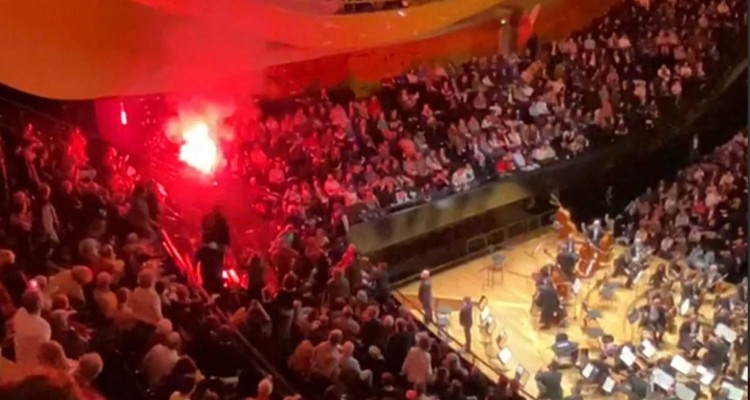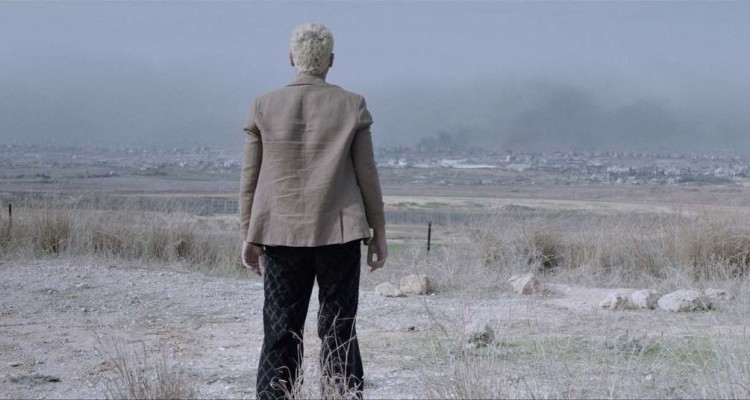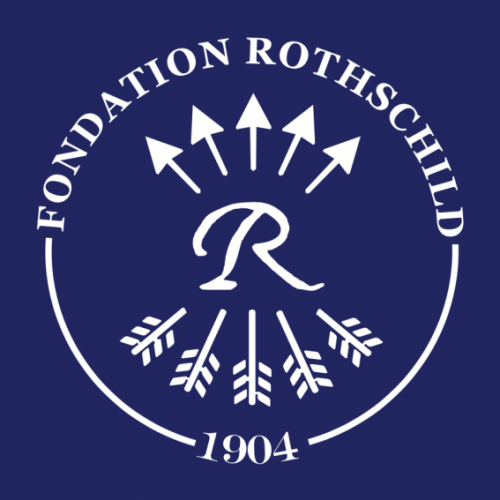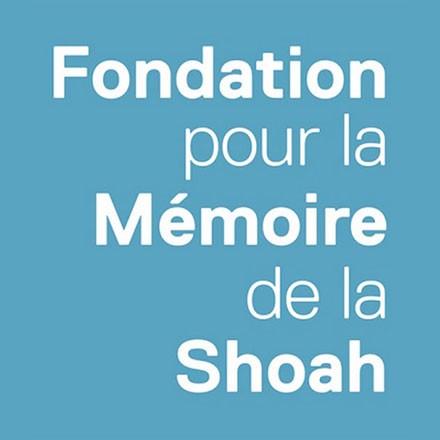Dybbuk, golems, zombies, spectres, werewolves and other Mazzikim, Jewish demonology has penetrated the cinema, but what does it have to tell us? Between memories of the Shoah, reflections on evil, the body or the unconscious, or even the quest for an alternative religiosity – on the occasion of the exhibition currently on view at the mahJ in Paris: “The dybbuk. Phantom of the lost world”, an investigation into one of Judaism’s most singular contributions to art and representation. By David Haziza, who has just published ‘Jewish myths. The return of the sacred‘, in the Diaspora book series published by Calmann-Lévy.[1]
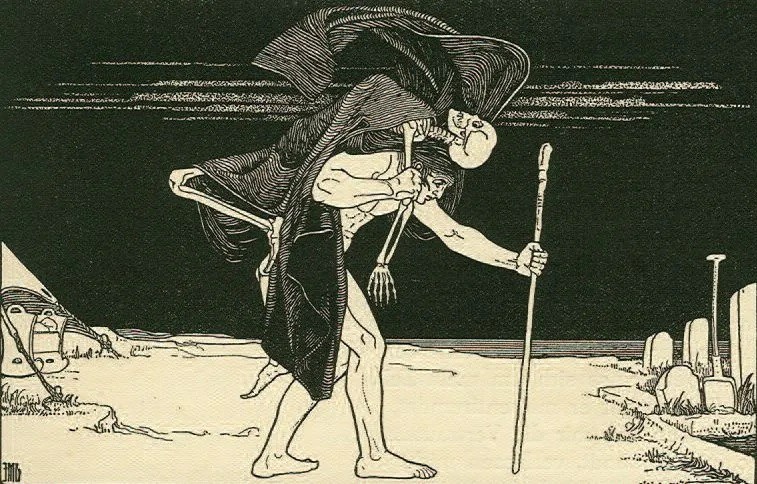
On September 19, 2015, filmmaker Marcin Wrona hanged himself in his hotel room in Gdynia, Poland. His film, Demon, had been shown in Toronto and was due to be shown again at the festival held there every year. It took place during the Yamim Noraim, the days of penitence from Rosh Hashanah to Yom Kippur, when the Book of Life is opened – for the living, but also for the dead. What is Demon talking about? About a dybbuk, a haunting that the director himself did not survive.
In Supernatural Horror in Literature, Lovecraft wrote around 1933[2] that Jewish mythology had considerably enriched the potentialities of fantastic literature through the theme of the golem and that of the dybbuk, the artificial man animated by religious magic on the one hand, and spiritual possession on the other. He cited not only Meyrink’s The Golem, published in 1915, but also An-Ski’s Yiddish play The Dybbuk, or Between Two Worlds, first performed in Vilna in 1917. What Lovecraft said about literature was already true of cinema, and is even more so today. The case of Demon – a retelling of An-Ski’s play and its film adaptation by Michał Waszyński (1937) – tends to prove this, although it went virtually unnoticed on its release. The recent history of Europe and that of the Jewish people are played out in this horror film.
The dybbuk is the spirit of a dead person speaking through the mouth of a living person to whom it has attached itself. This belief exists under various names in many cultures, notably shamanic, but is surprisingly absent from Christianity, where possession, a recognized phenomenon, is linked to demons rather than wandering souls: think of the devils of Loudun in the 17th century, or Friedkin’s The Exorcist[3]. The dybbuk also has a benevolent counterpart, the Ibbur, something that would be difficult to envisage in other Abrahamic religions where the haunting, when it exists, is necessarily evil. Whether dybbuk or Ibbur, Jewish mystical theology always refers to the “fertilization” of one soul by another, which needs this posthumous link to accomplish a task left unfinished.
Wrona’s film is about the return of a Jewish woman, Hannah, killed during the Shoah. Playing the spoilsport, she comes to take possession of the body of a Diaspora Pole, Piotr, whose wedding is being celebrated somewhere in Poland, a country he left long ago. It is also during her wedding that Leah, the heroine of Dybbuk, is penetrated by the soul of Honen, her beloved deceased. The symbolic sexual union is thus reversed, while the strictly Jewish meaning of the original drama is displaced. In both cases, the horizontal union of flesh summons up another, vertical bond, uniting generations. “Strong as death is Love”, proclaims the Song of Songs, the poem that structures An-Ski’s play and perhaps even more so Waszyński’s film, but also Wrona’s: love presupposes death, which it is at the same time uniquely capable of overcoming.
Whether dybbuk or Ibbur, Jewish mystical theology always refers to the “fertilization” of one soul by another, which needs this posthumous link to accomplish a task left unfinished.
It gradually becomes clear that the family of Demon’s bride, Żaneta, may hold the key to Hannah’s murder. When Hannah begins to speak through Piotr’s mouth, those present believe they are hearing German. It’s the priest who identifies the words as Yiddish. It will be up to the town’s last Jew, a “family friend”, to exorcise – or not – the troubled soul. He knew Hannah and undoubtedly loved her. For Marcin Wrona, the beauty and loves of Żaneta, pure as they were, must have recalled the spirits of the exterminated Jewess.
To take up an idea dear to Jacques Derrida, and which he was led to formulate through various writings or even during his own appearance in Ghost Dance, cinema – like psychoanalysis, which was born at the same time as it was – was to be, in Wrona’s eyes, “the art of letting ghosts come back”, of letting oneself be “ventriloquized” by dybbouks. Yes, “the cinematic experience belongs, through and through, to spectrality[4]”, and this return has an unmistakable ethical dimension: at a time when it has become fashionable to denigrate “repentance”, cinema can still teach us to listen to the complaints of the dead, for it is “a magnificent mourning, a work of mourning magnified. And it is ready to be impressed by all grieving memories, that is, by the tragic or epic moments of history”.
From its inception, cinema was seen as a new gateway to the abode of the dead, as painting and music had been, and as photography had been – but this time, it seemed to many of those early witnesses that death had simply been vanquished, or that it would forever permeate our existences through these visual traces, that it would mingle its spectres with them. Yet, as Derrida writes in Spectres de Marx, the specter is what dislocates time, makes it “come out of its hinges” and thus provokes ethical responsibility, that of the survivor, the witness, the heir. Cinema, the art of ghosts, can play such a role. “Come tonight at 10 o’clock to Edith Laurin’s for news about your dead. Signed: J’accuse! ” these words from Abel Gance’s film (1919), which introduce the fabulous ghost sequence, could be the tagline for Marcin Wrona’s film Demon.
A miniature or mise en abyme of cinema itself, dybbuk’s film could indeed fulfill a role similar to what Derrida says of Shoah, namely that it shows the extent to which this art “is the absolute simulacrum of absolute survival. It tells us what we don’t come back from, it tells us about death. Through its own spectral mirage, it shows us what should leave no trace. But in front of Lanzmann’s camera, the survivor bears witness to what he himself has experienced. The actor who plays the possessed man in Demon mimes his own condition on the one hand, and that of every heir, of every survivor on the other: the dead live in us and among us.
This is what Chen Shelach, an Israeli documentary filmmaker, also set out to tell in Muranów (2020). Muranów is the Warsaw district on the left bank of the Vistula where, before the war, two hundred thousand Jews congregated. Once surrounded by impenetrable walls, it was to become the Ghetto of the Polish capital. Completely destroyed after the 1943 uprising, the Muranów of 2021 seems to contain nothing of the Jewish existence that flourished there and was destroyed. A succession of gloomy buildings covers the alleys, parks, cafés, shops, synagogues and theaters, the bustling life of the last century – and Polish has uniformly replaced Yiddish. Yet today, many residents claim to be haunted, literally. Their houses are made of bricks with the bones of the dead mixed in, and objects and souvenirs are constantly being found in their underground tunnels. So it’s hardly surprising that the characters in this documentary tell us about “Rachel”, a little Jewish girl whose house is shared by a ghost, about the lights that go on and off for no reason in these modern apartments, about the strange, repeated noises that resonate there, about the sound of a violin or a child’s laughter that can be heard?
In Muranów, the organist’s refusal to be haunted by, or even believe in, dybbuks (his church is located in the old Jewish quarter) is clearly seen as a mistake. His words are not antisemitic, unlike those of other people filmed by Shelach, but they express an overplayed indifference that tells the whole truth of the situation: it’s not a question of hurting the Jews, no… but without them, Poland is better off all the same. It’s a pity their ghosts aren’t leaving too!
There’s something ironic about this “new” treatment of Jewish possession or haunting. The belief in the harmful power of spectres, whether materialized (vampires) or not (ghosts), is as old as humanity itself, and is often confusingly combined with demonology: the fairies of the Middle Ages are departed souls or cohabit with such souls; similarly, the folkloric vampire is often described as a demon in his own lifetime, or a man with diabolical powers. The Jew is all these things – dead or undead, demon, zombie, vampire and devil. The modern vampiric theme, both literary and cinematic, owes a great deal to the figures, particularly visual ones, invented by the antisemitic imagination. For Wrona, as for Shelach, the Jew – the Jewess in this case – is always spectral, more so than ever. Like Maupassant’s vampire or horla, he haunts, possesses and subdues a body, a gentile body. Only, as in The Dance of Genghis Cohn (original: La danse de Genghis Vohn), Gary’s droll novel in which a former Nazi is possessed by the dybbuk of one of his victims – a Jewish clown who died in Auschwitz – he does so now because the injustice and horror he has suffered have pushed time out of its bounds. It is the wickedness or indifference of gentiles that has brought him back from the dead.
The Jew is all these things at once – dead or undead, demon, zombie, vampire and devil. The modern vampire theme, both literary and cinematic, owes a great deal to the figures, particularly the visual ones, invented by the antisemitic imagination.
Another documentary, The Dybbuk – A Tale of Wandering Souls, by Krzysztof Kopczyński, dealt with this subject back in 2015, albeit this time as an active quest on the part of Jewish mystics: the wandering souls here are those encountered by Hasidic pilgrims to Uman, in the heart of ancient Podolia (Ukraine), where Rabbi Nahman of Bratslav is buried. This film explores the hatreds and grudges between these two peoples, Jews and Ukrainians. It does not spare the Hasidim, whose various excesses, even racism, are evoked. But at the same time, it shows the persistent brutality of anti-Jewish hatred. In this context, one scene deserves mention. A group of Hasidim visit a dilapidated psychiatric asylum to play music. These “switched-on” mystics are looking for souls in pain, whose energies they believe they can capture and redeem. Their message is universal: Judaism is the religion of a singular people, but one that radiates out to others. In Lurianic doctrine, from which Hasidism draws its inspiration, the return of souls to earth is linked to the process of repairing the world – Tikkun Olam. Behind the dybbuk are a multitude of divine sparks, trapped by the forces of evil and scattered throughout the universe. This scene is memorable for its depiction of an invisible part of the cosmos in a way that only cinema is capable of.
By suggesting that there is, for Jews, a duty to devote themselves to the dead in search of redemption, Kopczyński’s film in a way revives the original theme of the dybbuk. Indeed, while Gary and Wrona imagined the haunting of gentiles, and Muranów described it as realistically as possible, An-Ski’s play, like the traditional tales from which it draws, tends to make the dybbuk a Jewish affair. It is Sender’s injustice, his betrayal, once he became rich, of the pact that bound him to his friend Nissen, that will precipitate the catastrophe of the dybbuk: the possession of Leah, by the soul of Honen, Nissen’s son to whom she was promised – his Bashert. This play and film have been seen as a premonition of the Shoah. This fails to realize that, while the world described by An-Ski and Waszyński is on the eve of its demise, this demise is first and foremost the result of its own tensions[5]. Both works deal with the tensions within the Jewish people – between rationality and mysticism, between rich and poor, between men and women, between heterosexuality and homosexuality…
The Coen brothers, in A Serious Man (2009), have resurrected these “internal” aspects of the myth, making the dybbuk the designation of a Jewish self-criticism, in this case a critique of assimilation. The film has an undeniable supernatural dimension, particularly in its Yiddish prologue: Reb Groshkover, a man who has returned from the dead – played by the elderly Yiddish actor Fyvush Finkel – is identified as a “dybbuk”. Technically, he’s more like a zombie, since a dybbuk is a soul attached to the body of a living person, not a body raised from the grave. From the Talmud[6] and from Shivh’ei haAri (16th century) to Charles Lewinsky’s Melnitz, via Isaac Bashevis Singer’s short story “Two Corpses Go Dancing” and Isaac Leib Peretz’s Night in the Old Market, The dream scene in The Fiddler on the Roof, although presented as an invention by Tevyeh, belongs to the same imaginary world and similarly conjures up a dead woman resurrected in her flesh. </footnote>, Jewish literature and art, for whom it can indeed happen that a deceased person returns in his or her very flesh. What does Reb Groshkover have to say? This prologue is set in an indeterminate time and place, dislocating in advance the material and bodily comforts of well-trimmed lawns, impeccable tans and nose jobs of the Americanized Jews who will be at the heart of the film. In A Serious Man, otherwise inspired by Job, the leper condemned to live on a pile of excrement but still yearning to see God “from [his] flesh” even[7], it’s the reminder of Jewish flesh, of its own blend of the grotesque and the sublime. Rabbinic Judaism has made a dogma out of the belief in resurrection, body and soul. The zombie is the premature resurrection.
In short, Jewish fantasy evokes a questioning of identity, if not return itself, of Teshuvah. Dybbuk aside, this is the case in Aronofsky’s Pi (1998), a reading of the Book of Ezekiel, in which a New York mathematician, Jewish but atheist – and above all schizophrenic – obsessed by the discovery of an order that would govern the chaos of the number π, is contacted both by unscrupulous financiers and by members of a messianic Hasidic group for whom his discovery could lead to the discovery of the secret name of God, and thus to the end of time. Max Cohen is haunted by a task, a call that is absolutely beyond him – and like Ah’er, the Faust of the Talmud, he loses himself (or finds himself) in his quest to exhaust the mysteries of Creation.
This questioning is echoed in The Vigil, by Keith Thomas (2019). A young OTD (for “ off the derech ” – “off the righteous path” [not living the Orthodox lifestyle anymore]), an ex-hassid, is called to serve as Shomer in the house of a survivor of the camps: he must watch over his remains while reciting the psalms. However, this house is haunted by a Mazzik[8], a demon that had been attached to old Litvak since the Shoah and had driven him mad. “These aren’t nightmares, they’re memories,” his widow tells the Shomer, harassed by terrifying mental images sent to her by the deceased. In the space of one night, he will have to reconnect with Jewish practice to counter their harmful power[9]. Brooklyn’s Hasidic communities were formed after the war, and the memory of the extermination was so structuring that, according to some “renegades”, it imprisoned subsequent generations. Thomas’s film aims to exorcise and at the same time – like all exorcisms – to name and elucidate.
Sometimes, moreover, the fantastic heralds a different kind of Judaism. An Israeli film released in 1994, Shmuel Hasfari’s Shh’ur, contrasts the spirituality of Moroccan women, imbued with the supernatural (“superstitions”), with that of their husbands. The former’s alternative, syncretic rites reflect the immemorial power of the mother, of the vainly repressed Goddess – the Shekhinah. As early as The Dybbuk, this problematization of the religious by the demonic is present, as Honen experiments with the sanctity of sin. The appearance of the dead – in the film, where it is displayed in an expressionist and carnivalesque form, even more so than in the play – redoubles the underlying social and religious critique. As for the exorcism, it proves only partly effective: Honen agrees to leave Leah’s body provided that Sender says Kaddish for him, but Leah, once “freed”, sacrifices herself to join her beloved in death. This is not to deny the Rebbe’s power, but that power, perhaps because it is corrupted by money, is no match for the magical love of the two heroes.

The Dybbuk and Shh’ur share a common “primitivist” bent, referring to the quest for a spiritual “out there”. Gabriella Safran has shown what An-Ski’s play owed to his interest in Siberian cultures[10]. The Hasidim of Podolia and Volhynia, the Judeo-Berber matrons of Morocco share with the shamanistic populations of the Russian Far East a kind of communal primitiveness. In the eyes of An-Ski, who was an ethnographer as well as a socialist and revolutionary, this dimension could make political sense. Sender, the capitalist, is everything this mystical order is not. In Shh’ur, the order in question is explicitly matriarchal – and in each of the works, this recourse to the past and its irrationality would have the merit of breaking the injustice of the present.
If the emergence of Jewish fantasy in cinema is linked to the obvious cinegeny of traditional Judaism and Jewish rites, it can also take place without any apparent Jewish signifier.
Finally, a word about the imperceptible contributions of Judaism to the fantasy genre. Two examples will suffice. If the emergence of Jewish fantasy in cinema is linked to the obvious cinegeny of traditional Judaism and Jewish rites[11], it can also operate without any apparent Jewish signifier. Polanski’s The Tenant is clearly a fantastic Jewish work, in which a Polish immigrant (who believes himself to be) besieged by his neighbors also believes himself to be a certain Simone Choule (like the shul, the synagogue), or refuses to be confused with her, while inexorably assuming this identity. It’s the theme of the double, of the double life, that animates many Jewish or Judaism-inspired stories, starting with Jacob’s nocturnal struggle against an anonymous figure in whom rabbinic tradition sometimes sees his guardian angel, sometimes the protective force of Israel’s enemies, sometimes himself and sometimes the specter of his brother and enemy, God or the Devil. Trelkovsky’s becoming-woman could also be seen as a kabbalistic reminiscence: we know that in Lurianic Kabbalah, some men’s souls differ sexually from their bodies<footnote>https://k-larevue.com/proust-le-talmud-et-la-kabbale/</footnote>. But Le Locataire is also, and for all these reasons, a fable about the impossibility of assimilation, and the spiritual and mental turmoil that this utopia inevitably brings.
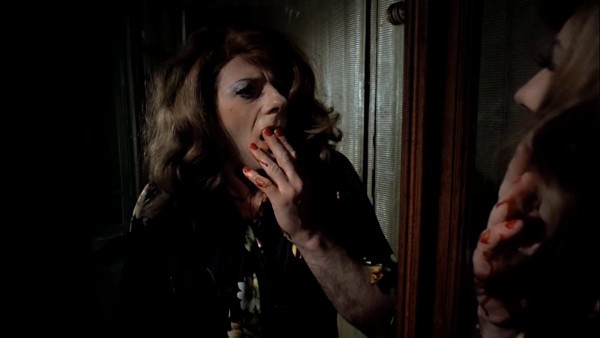
Similarly, Mike Nichols’s all-too underrated Wolf can also be read as an allegory of the Jewish condition: the Jew of modernity is a hybrid being, hiding within himself primitive and ambivalent forces, seen by antisemitism as corrupt and corrupting, the ferment of “psychic epidemics”, as Meyrink writes in The Golem, of sometimes abrupt revivals prompted by his very archaism. It is “genius” because it stands beyond good and evil.
But there’s something more essential. In this film, a publisher (from New York, but not necessarily Jewish) finds his creative powers increased tenfold by his lycanthropy. It is said that, in Genesis, Creation is described as “excellently good” only in its final state, because only then was the inclination to evil created. All his labor, it is this inclination that will drive man to indulge in it[12]. Jewish anthropology is entirely founded on this paradoxical and, as it were, lycanthropic intuition, which seems to turn the Augustinian notion of original sin on its head. To these general considerations, let us add a detail that Nichols was probably unaware of: belief in the werewolf was shared by Jews for a long time, even penetrating the elitist and literary culture of the German pietists of the 12th and 13th centuries. Among the latter, we find astonishing analogies between lycanthropic metamorphosis, the possibility of which everyone believed in at the time, and the angelic metamorphosis of certain characters in the Bible, even the idea that man’s metamorphosis into a wolf necessarily follows from his creation in the image of God: Randall, the hero of Wolf, by becoming a werewolf and accepting it, acquires not only immense powers, but even a kind of immortality.
In both these cases, as in the examples above, existentialist reflection is nourished by the Bible and Jewish tradition, as well as by the vicissitudes of history. These are all examples of the salvific archaism of the Jew in modernity.
David Haziza
Researcher and essayist, David Haziza holds a doctorate from Columbia University (New York). He has taught European history, French literature and cinema. He has published ‘Talisman on your heart‘ (Cerf, 2017), an exegesis of the Song of Songs, and ‘Le Procès de la chair’ (Grasset, 2022), an essay on contemporary Puritanism. His latest book, ‘Mythes juifs. Le retour du sacré‘ has just been published in the Diaspora book series by Calmann-Lévy.
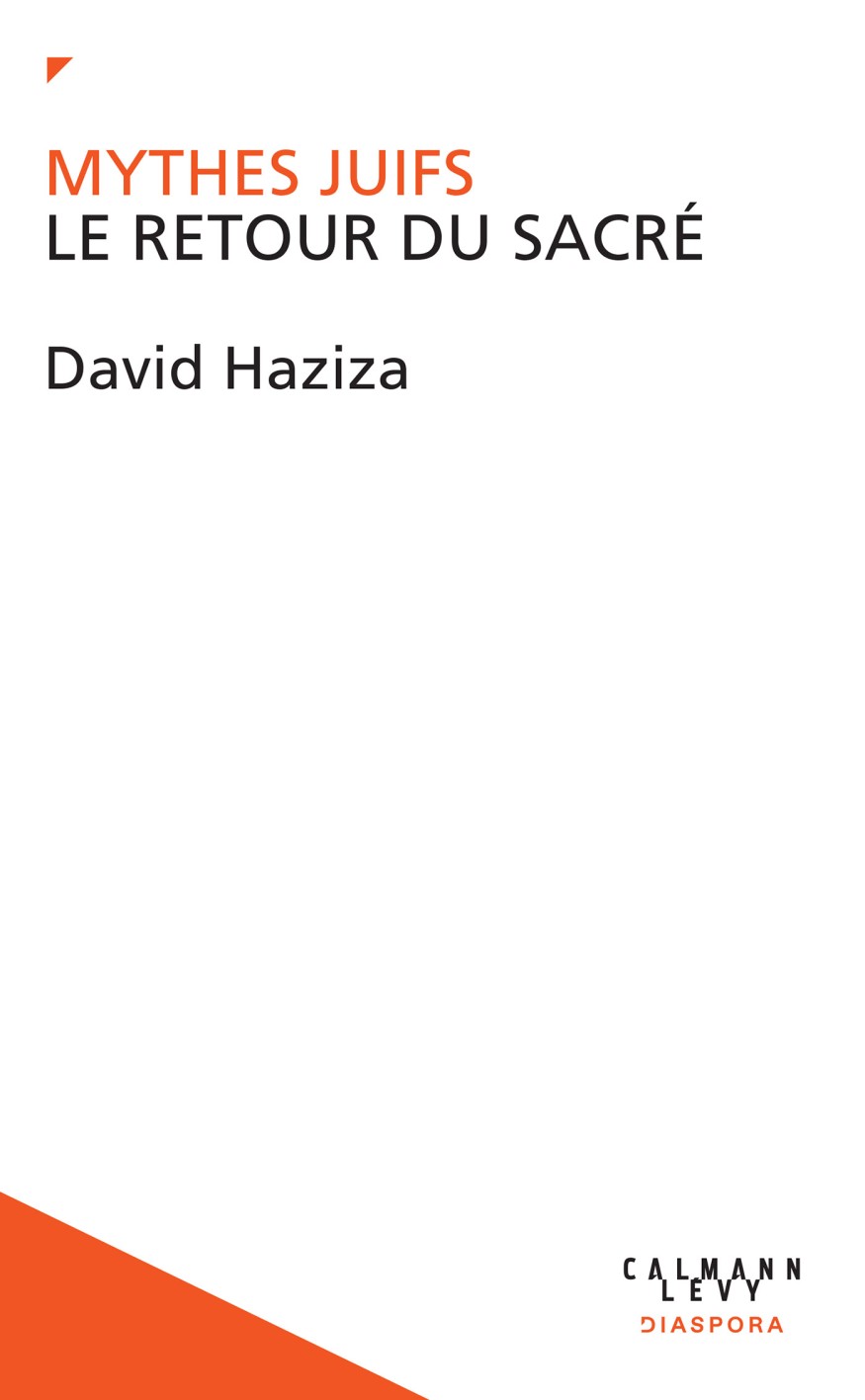
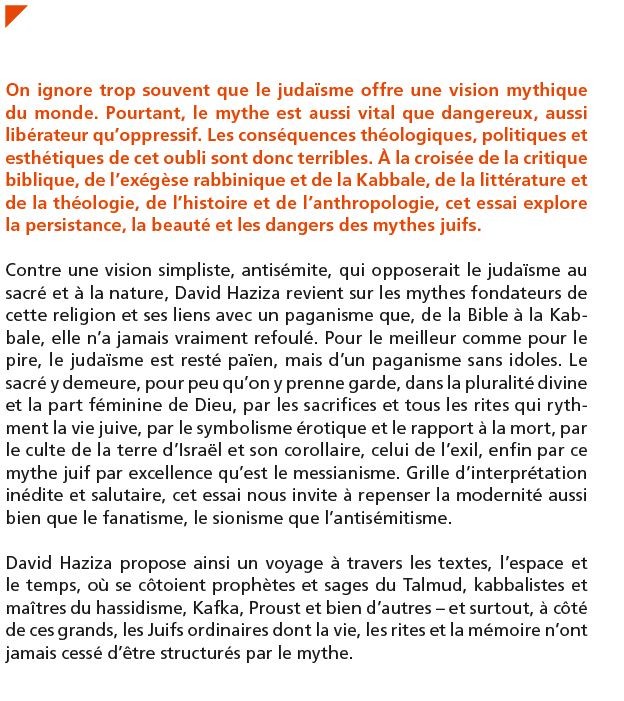
Notes
| 1 | https://www.calmann-levy.fr/livre/mythes-juifs-9782702189610/ |
| 2 | In Supernatural Horror in Literature. |
| 3 | Friedkin is Jewish but the rhetoric of The Exorcist is Christian. |
| 4 | ”Le cinéma et ses fantômes“, interview by Antoine de Baecque and Thierry Jousse, Les Cahiers du Cinéma, April 2001. |
| 5 | See Glenn Dynner, Men of Silk – The Hasidic Conquest of Polish Jewish Society, New York, Oxford University Press, 2006. The subject is central to Israel Joshua Singer’s novel Yoshe the Madman. |
| 6 | See for example Ketubot, 103a, where it is reported that Rabbi Judah HaNasi returned every Shabbat after his death, in his body and best finery. Sanhedrin, 92b, takes Ezekiel’s parable of the dry bones literally, asserting that these resurrected dead even had descendants. Later sources emphasize the evil element of such pre-Messianic resurrections. A famous Shivchei haAri story tells of a Galilean woman who died a virgin. A young thug, seeing her finger sticking out of the ground, passes her a wedding ring in mockery. The next day, she returns to claim her due. |
| 7 | Job, 19: 26. |
| 8 | See Pesah’im 110a. |
| 9 | This emergence of the Jewish supernatural in modern life is the subject of a French short film, Dibbuk, by Dayan David Oualid. This time, the exorcism takes place in a Sephardic environment, in the 19th arrondissement of Paris. The demonic and the divine come to subvert the sad normality of a breathless urban space. The rite offers itself as a response to contemporary obsolescence. |
| 10 | Gabriella Safran, “Jews as Siberian Natives – Primitvism and S. An-Sky’s Dybbuk ”, in Modernism/Modernity, 2006. |
| 11 | , the plethora of recent productions on this theme bears witness to this. But we can also think of films made much earlier, which can, if need be, tell the story of a departure from tradition: Das alte Gesetz, from 1923, or The Jazz Singer from 1927. The two versions of Le Juif Süss, Lothar Mendes’ anti-Nazi version (1934) and Veit Harlan’s more famous version (1940), precisely because of its antisemitism, also attest to a kind of aesthetic fascination with Jewish rituality. In Harlan’s film, this fascination is obviously displayed with a guilty conscience. It can be found in films as diverse as Pabst’s The Trial (1948) and… The Adventures of Rabbi Jacob (1973). The exoticism of the Jewish rite was combined with horror as early as Waszyński’s Dybbuk, but also in Wegener’s (1920) and Duvivier’s (1936) Golem. We could also mention another Golem, Jean Kerchbron’s film (1967), co-written by Louis Pauwels and directly inspired by Meyrink’s novel. |
| 12 | Bereshit Rabbah, IX, 7. |
